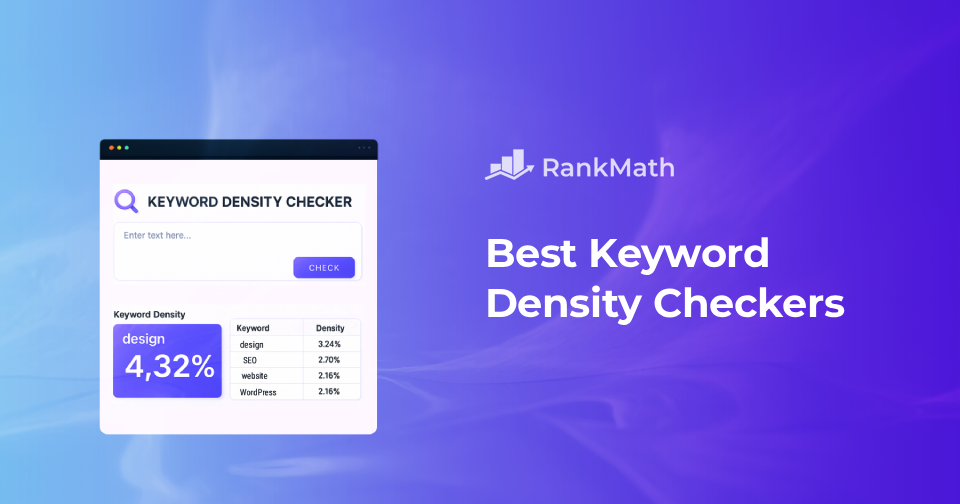If you’re creating content for SEO, you’ve probably heard about keyword density. The tricky part is knowing whether you’re hitting the right balance.
Here’s the truth: Google doesn’t care about a perfect percentage. No magic number will suddenly boost your rankings. What matters is how naturally your keywords fit into your content.
Use your keywords too little, and search engines may not see your content as relevant. Overdo it, and you risk keyword stuffing, which can hurt both your rankings and user experience.
So how do you find the right balance? That’s where keyword density checkers come in. These tools show you exactly how often your keywords appear and help you optimize naturally.
In this guide, I’ll walk you through the best keyword density checkers you can use today. Some are fast and free, while others use AI to give smarter recommendations for on-page SEO.
Table Of Contents
- What is Keyword Density?
- Why Use a Keyword Density Checker?
- Top Keyword Density Checker Tools for Better SEO
- Rank Math SEO
- SE Ranking Keyword Density Checker
- SEO Review Tools Keyword Density Checker
- Small SEO Tools Keyword Density Checker
- WebFX Keyword Density Checker
- CheckSERP Keyword Density Checker
- Frequently Asked Questions
- Conclusion
1 What is Keyword Density?
Keyword density refers to how often a keyword appears in your content compared to the total word count. The formula looks like this:
Keyword Density = (Keyword Count ÷ Total Word Count) × 100
For example, if you write a 1,000-word article and your target keyword shows up 10 times:
(10 ÷ 1000) × 100 = 1%
That means your keyword density is 1 percent.
For me, instead of chasing exact percentages, I prefer to use my primary keyword naturally and then sprinkle in related terms (LSI or semantic keywords). This way, my content reads smoothly for people while still staying optimized for search engines.
2 Why Use a Keyword Density Checker?
A keyword density checker analyzes your content to show how often keywords appear, where they’re placed, and whether the usage feels balanced.
You might wonder, “Do I really need one?” From experience, I can tell you these tools save time and help you avoid common mistakes. Here’s why they’re worth using:
- Avoid keyword stuffing penalties: Overusing a keyword makes content look spammy to both readers and Google. A checker flags this before it becomes a problem.
- Optimize content naturally: Seeing the numbers helps you fine-tune your writing so it flows well without feeling forced.
- Analyze competitors: Drop in a competitor’s URL and instantly see how they balance keyword usage. It’s an easy way to reverse-engineer what works.
- Improve readability and SEO alignment: When a checker highlights overused phrases, it helps you diversify with synonyms and related terms, keeping your content engaging while still SEO-friendly.
- Leverage AI insights: Some tools now use AI to suggest fixes, making optimization faster and more accurate without compromising quality.
3 Top Keyword Density Checker Tools for Better SEO
To help you find the right balance, here are the best keyword density checkers I recommend. Some are free and simple, while others go deeper with AI and real-time optimization.
3.1 Rank Math SEO
Rank Math SEO is my top pick because it integrates keyword density checks directly into WordPress. While I’m writing, it shows exactly how often I’ve used my primary and secondary keywords and highlights where they appear, like in the title, meta description, or first paragraph.
Setting it up is simple. Install Rank Math on your WordPress site, navigate to the post you want to optimize, and insert your keywords into the Rank Meta box.
The plugin analyzes your content, counts keyword occurrences, and calculates a keyword density score. If the density is too low, it alerts you; if it’s too high, it flags it to prevent keyword stuffing.
What sets Rank Math apart is its Content AI feature. Instead of simply issuing warnings, it offers a Fix with AI button that generates content suggestions to help resolve keyword density issues.
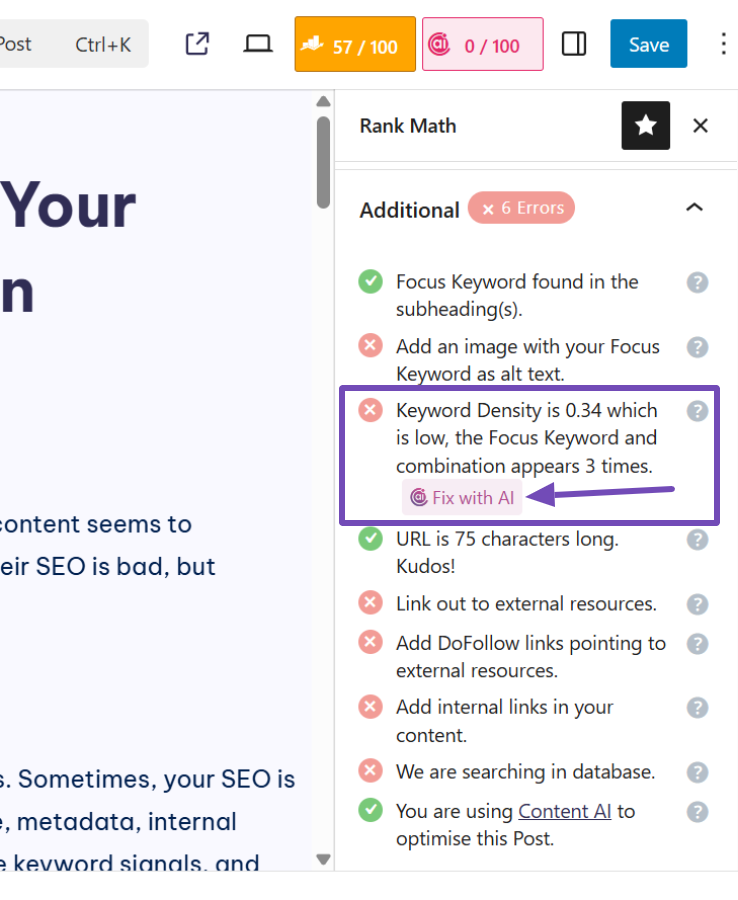
Once applied, your content remains smooth, readable, and SEO-friendly.
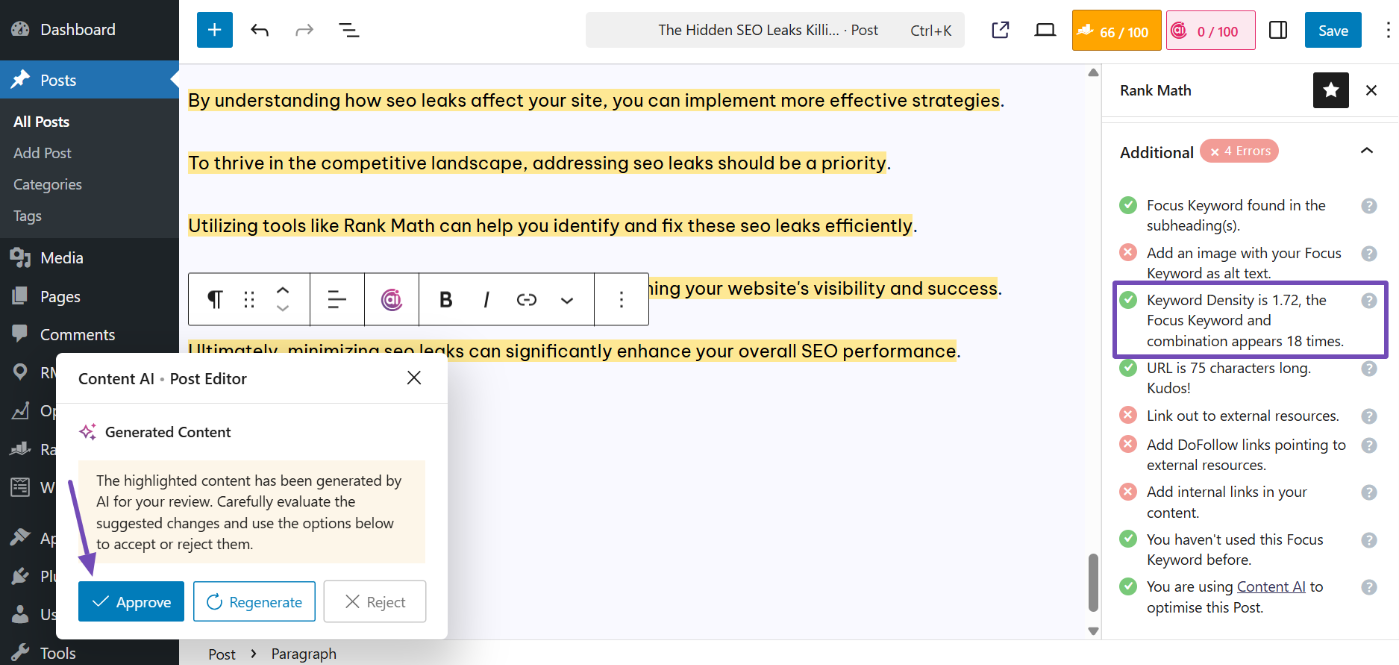
Pros:
- Built directly into WordPress, no extra setup.
- Monitors both primary and secondary keywords in real time.
- Provides additional SEO optimization options within the editor.
- Content AI provides actionable suggestions to address keyword density issues naturally.
Cons:
- The free version is robust, but Content AI requires credits from paid plans.
Best for: Bloggers, freelancers, and small business owners who want a reliable WordPress SEO plugin that keeps keyword density under control without overcomplicating things.
Price: Rank Math is free. Paid plans start at around $$95.88/year for PRO, which includes Content AI credits. Credits can also be purchased separately starting at $71.88/year.
3.2 SE Ranking Keyword Density Checker
If you want something quick and easy, SE Ranking’s Keyword Density Checker is solid. I like it because it’s flexible, free, and online; you don’t even need to install any software.
You can drop in a URL, paste your content, or even analyze search results directly. You can paste your content, drop a URL, or check search results.
Let’s say you use the URL option; you can add up to three pages at once, and enter the exact keywords you want to track.

Once it’s done, it displays the density of each keyword in percentage and the number of times it appears.
There is also a download button, allowing you to obtain a CSV and check if you’re overusing or underusing certain terms.
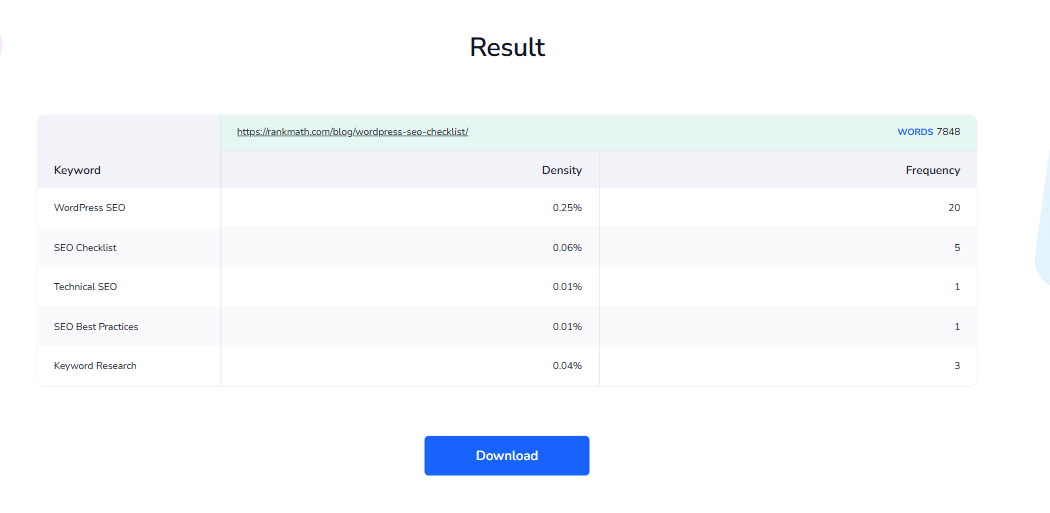
Pros:
- Totally free and super fast for keyword density checks
- Let’s you analyze URLs, raw text, or even SERPs
- You can track the keywords that matter most to you
- Export results if you want to dig deeper
Cons:
- You have to enter a keyword before running the check
- It doesn’t show placement details like headings or meta tags as thoroughly as some other tools
Best for: Bloggers, freelance writers, or anyone starting with SEO who wants a simple, free keyword density tool without extra fluff.
Price: Free
3.3 SEO Review Tools Keyword Density Checker
If you want a straightforward, free keyword density checker, SEO Review Tools is a solid choice.
You can paste your content, drop in a URL, or even analyze search results, and it instantly shows how often your keywords appear. No sign-up is required, making it highly convenient.
For example, if you use the URL input, just enter the page you want to check, exclude any keywords you don’t want measured, and hit Perform Check.

Once the analysis is done, it breaks down single keywords as well as two-word and three-word phrases.
This helps you spot patterns that you might miss, such as accidental repetition or gaps in your keyword usage.
It also gives you density percentages and frequency counts, and you can expand options to explore keyword research, volume, or even content ideas for the keywords you’re targeting. It’s a great way to make sure you’re avoiding keyword stuffing while keeping your content optimized.
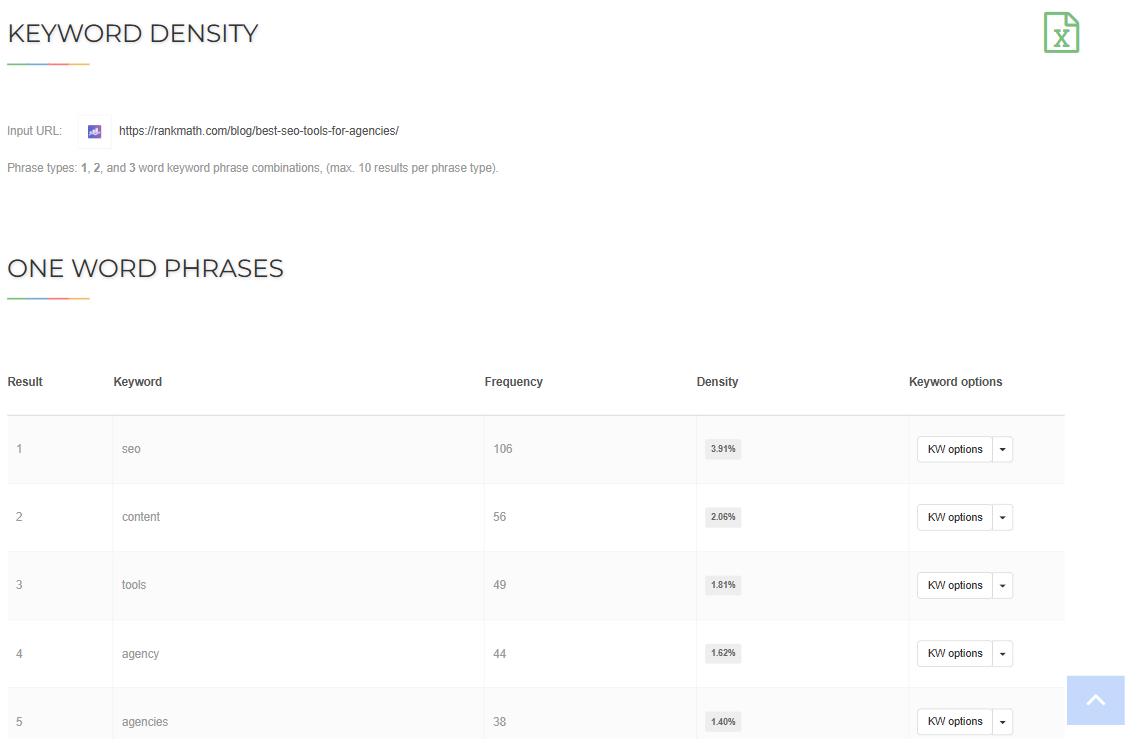
Pros:
- Quick and completely free
- Works for live URLs, drafts, or search-based content
- Breaks down 1-, 2-, and 3-word phrases for deeper insights
- Export results for further analysis
Cons:
- Captcha appears before some checks.
- No direct AI-powered suggestions to optimize content automatically
Best for: Bloggers, freelancers, or small businesses who want a simple, no-frills keyword density checker without paying for a full SEO suite
Price: Free for single checks
3.4 Small SEO Tools Keyword Density Checker
If you just need a fast and free keyword density checker, Small SEO Tools is one of the simplest options out there.
Simply paste your content or enter a URL. If you use the URL option, you can even check meta tags, titles, and alt text by ticking the checkboxes.

Once the analysis is complete, it displays the top keywords, both single words and phrases, and shows you how often each keyword appears in your content.
You can immediately spot their presence in headings, meta descriptions, and titles if you selected those options.

A key advantage is that it doesn’t just stop at single keywords. It also breaks down two-word, three-word, and four-word phrases, making it easy to spot accidental repetition and overuse.
You get the frequency and density of these phrases, which helps ensure your content optimization stays natural while avoiding keyword stuffing.

Pros:
- Completely free and super fast
- Works for both draft text and live web pages
- Analyzes single keywords as well as two- to four-word phrases
- Shows placements in headings, meta tags, and alt titles
Cons:
- No AI suggestions to fix keyword issues
- Ads on the site can be distracting
- No option to download results
Best for: Bloggers and small site owners who want a quick, no-cost way to check keyword balance before publishing
Price: Free
3.5 WebFX Keyword Density Checker
When you need a quick but detailed keyword density checker, WebFX is a solid option. You can either paste your content or enter a URL, and it will show exactly how often your keywords appear in titles, meta descriptions, and headings (H1–H6).
This makes it easy to check if your main terms are appearing where they matter most.
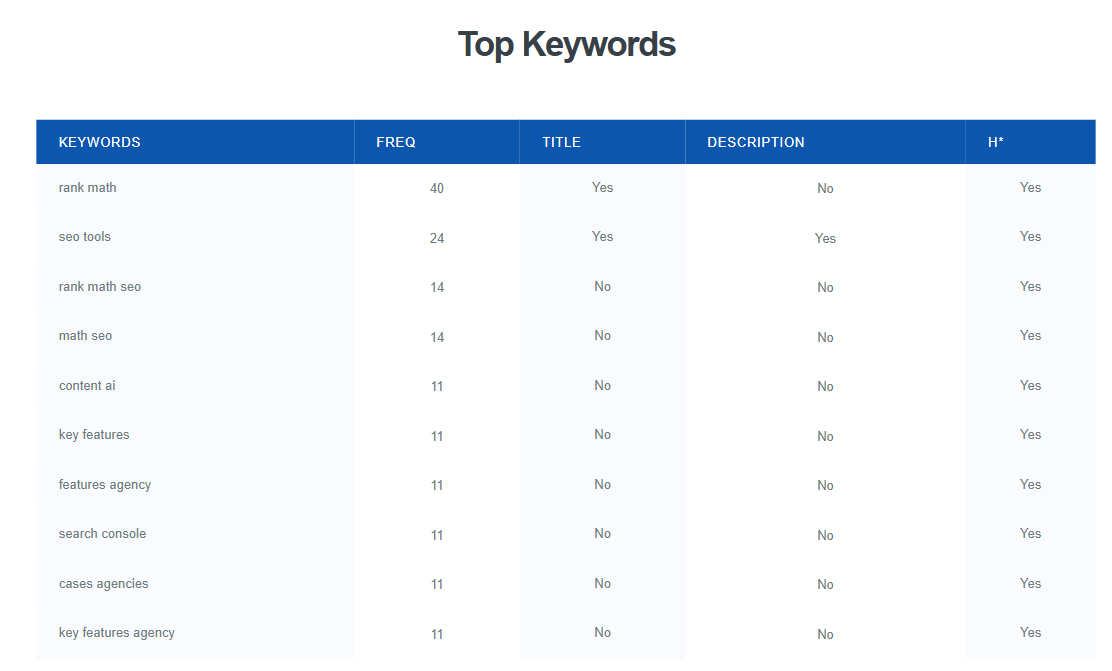
On top of that, WebFX breaks your content down into one-word, two-word, three-word, and even four-word phrases.
It displays both the frequency and density percentage, giving you a layered view that simplifies spotting keyword stuffing or missed opportunities.
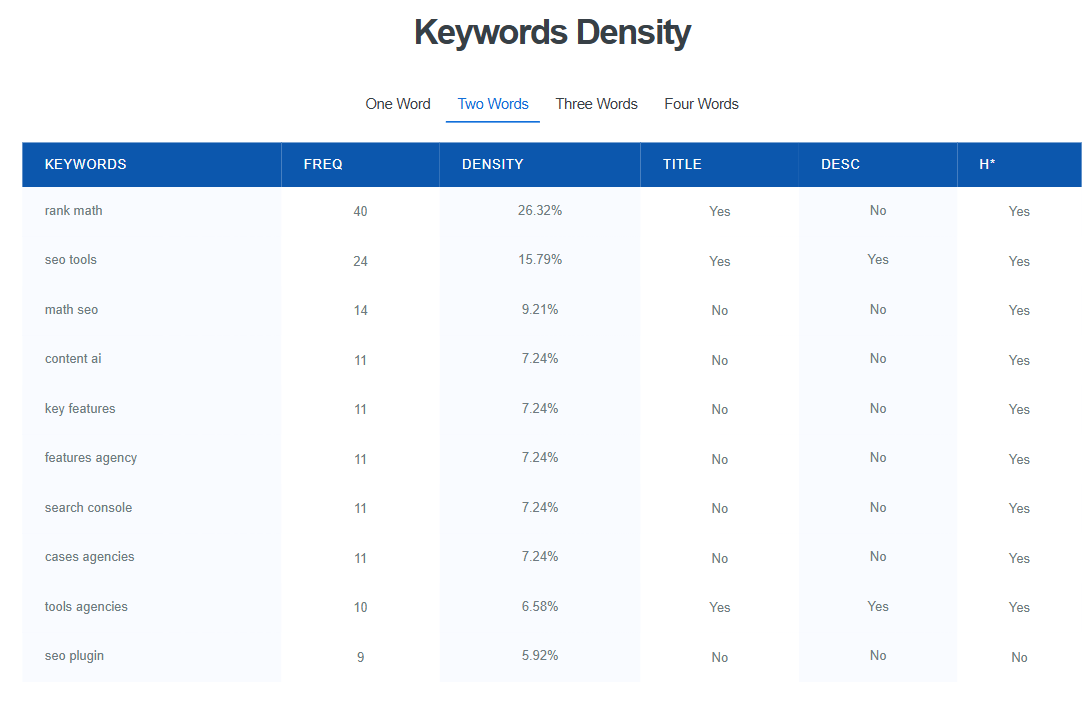
Pros:
- Shows frequency for single and multi-word phrases (up to four words)
- Highlights placement in titles, headings, and alt text, not just counts
- Completely free for basic checks
Cons:
- No AI-powered suggestions to help balance your keywords
- Doesn’t indicate whether your keyword density is too low or too high
- No option to download results
Best for: Bloggers, freelancers, and site owners who want a simple way to check keyword distribution across metadata and body content
Price: Free
3.6 CheckSERP Keyword Density Checker
When you need a fast, clean keyword density checker, CheckSERP is a solid tool. You can paste your draft or drop in a URL, and it starts analyzing right away. A standout feature is the ability to fine-tune results for more accurate insights.
You can filter stopwords, set a minimum word length, or choose how many keyword phrases you want to see.
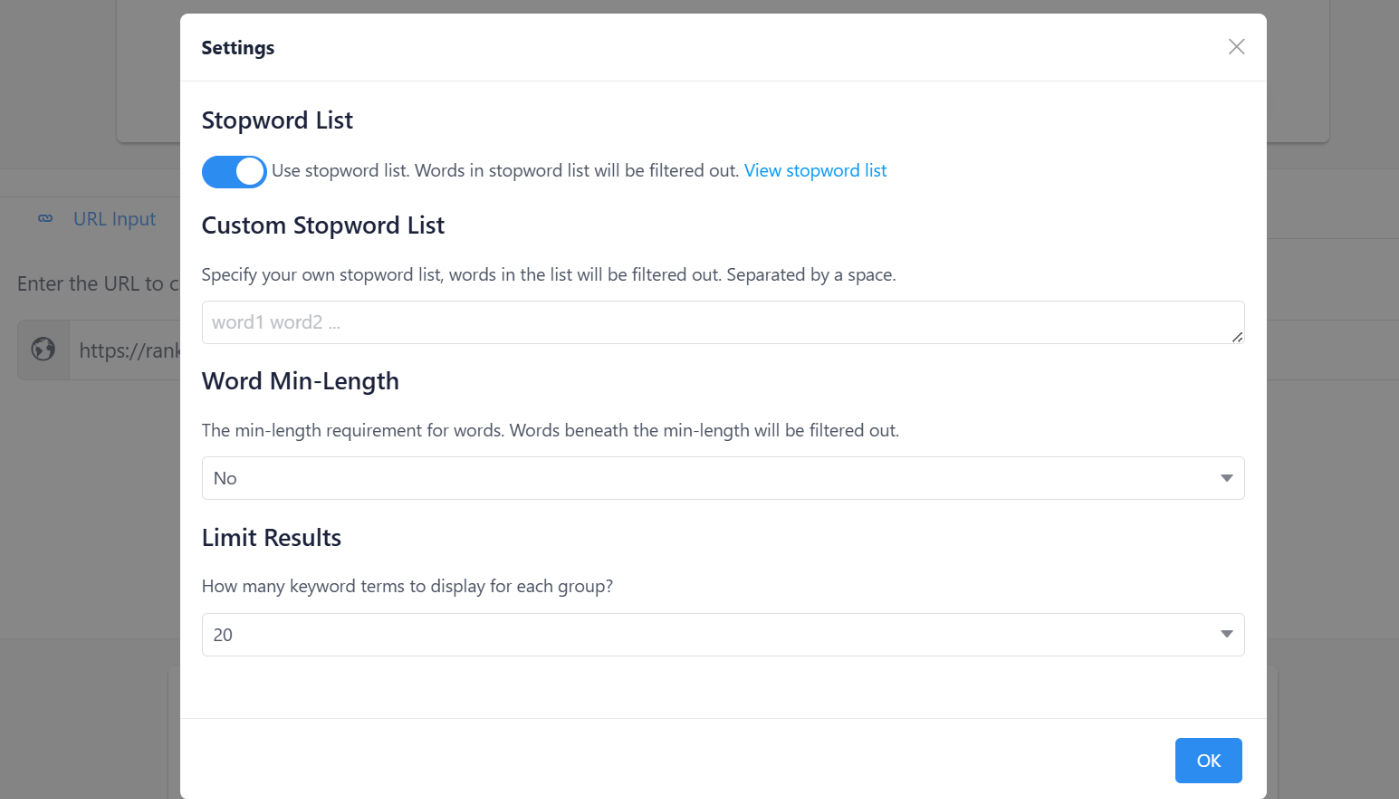
The tool breaks your content into one-word, two-word, three-word, and four-word phrases, showing both frequency and density percentages.
It also checks if your keywords appear in the meta title and description, which is extremely useful for tightening up on-page SEO before publishing.
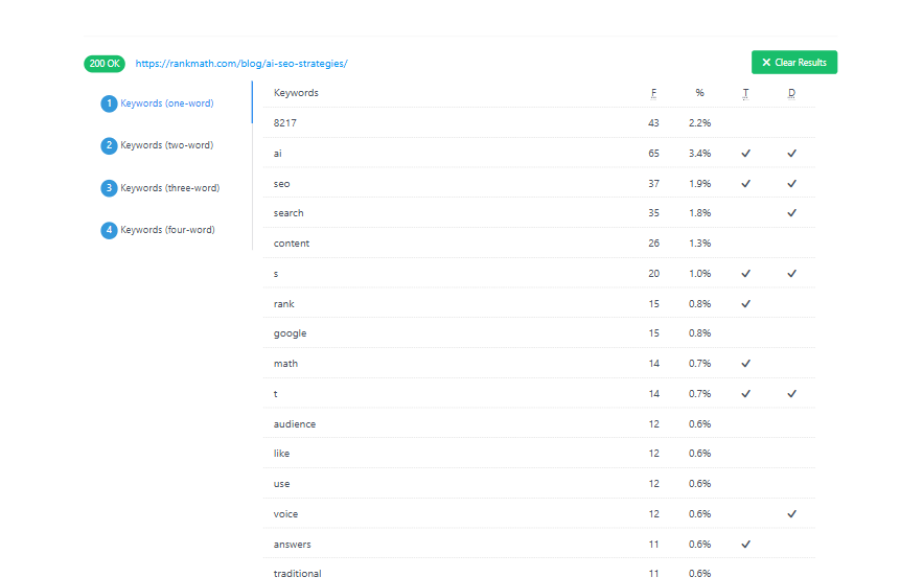
Pros:
- Works for both drafts and published pages
- Phrase-level breakdowns up to four words with counts and percentages
- Highlights if your keywords appear in titles and meta descriptions
- Customizable output for clearer, more useful data
Cons:
- No AI-powered suggestions to balance keyword usage
- Some ads on the site
- Not search-based like other tools
Best for: Writers, bloggers, or anyone who wants to double-check keyword usage before publishing. Also handy for reviewing competitor pages.
Price: Free
4 Frequently Asked Questions
What is the optimal keyword density for SEO in 2025?
There is no magic number, but aiming for around 1 to 1.5 percent is usually safe. Google does not rank content based on strict percentages. It prioritizes natural language and user intent. Focus on writing for people, then use LSI (related) keywords to boost relevance without stuffing. Tools like Rank Math SEO can help you monitor and maintain a balanced approach.
Can a keyword density checker help me avoid keyword stuffing?
Yes. A good checker will flag excessive use. For example, anything above 3 percent can look spammy. Some, like Rank Math SEO, even suggest synonyms and related keywords so you can diversify your writing. The key is to keep readability and value front and center, not just density numbers.
Which keyword density checker works best with WordPress?
Rank Math SEO is the easiest option if you are using WordPress. It integrates directly into the editor, gives you real-time keyword density stats, tracks multiple keywords, and even provides readability feedback as you write.
Is there a keyword density checker with AI features?
Yes. Tools like Rank Math SEO use AI to analyze keyword placement, suggest semantic terms, and guide you toward more natural optimization. That means you are not just hitting percentages, you are improving overall content flow and SEO.
How do I manually calculate keyword density without a tool?
The formula is simple: Keyword Density = (Keyword Count ÷ Total Word Count) × 100.
So, if your keyword appears 15 times in a 1,500-word post: (15 ÷ 1,500) × 100 = 1 percent. That said, tools like Rank Math automate this process and account for variations, saving time and reducing the likelihood of mistakes.
5 Conclusion
Keyword density isn’t about hitting a perfect number; it’s about making sure your content stays relevant, readable, and engaging.
The tools I shared make it easy to see where your keywords appear, prevent over-optimization, and even offer AI-driven suggestions to improve your content naturally. Whether you use a free checker like CheckSERP or a full-featured plugin like Rank Math SEO, the key is balance.
Focus on writing for your audience first, then use these tools to fine-tune your SEO for better search engine performance. If you’re on WordPress, Rank Math SEO is a top choice.
Try one of these tools on your next article. You might be surprised how much easier content optimization can become.
If you like this post, let us know by Tweeting @rankmathseo.
